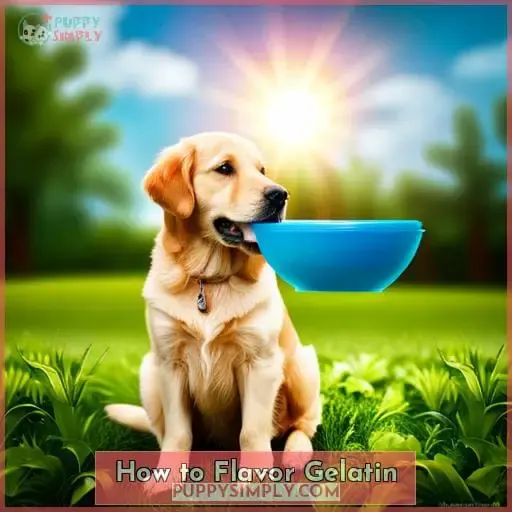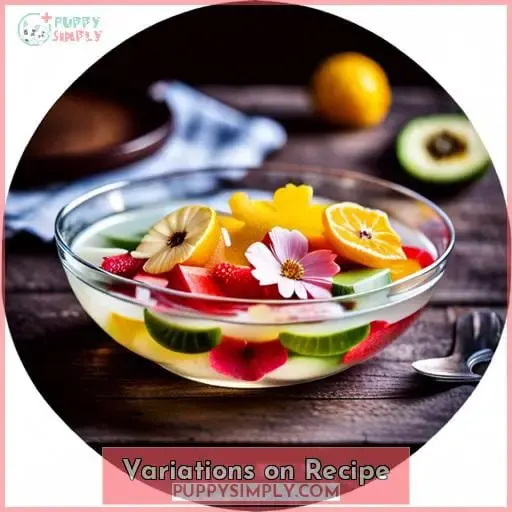This site is supported by our readers. We may earn a commission, at no cost to you, if you purchase through links.
 Curious about whether your pup can enjoy Jello gelatin? While it may seem harmless, it’s important to understand the risks of feeding such a sugary treat to man’s best friend. In this article, we’ll explore what is in Jello and how safe it really is for dogs.
Curious about whether your pup can enjoy Jello gelatin? While it may seem harmless, it’s important to understand the risks of feeding such a sugary treat to man’s best friend. In this article, we’ll explore what is in Jello and how safe it really is for dogs.
We’ll also look at some alternative recipes that are safer yet still tasty enough for your pup! Can dogs eat Jello? Risks & Safe Alternatives has all the answers you need when considering if Jello gelatin treats are right for your furry friend.
Table Of Contents
Key Takeaways
- Dogs should avoid eating Jello due to unhealthy ingredients: sugar, artificial flavors, and colors.
- Unflavored plain gelatin is a safer alternative for dogs.
- Flavored Jello should never be given to dogs due to high sugar content and potential inclusion of xylitol.
- Gelatin capsules made from animal sources are safe for dogs in moderation.
Can Dogs Eat Jello?
You should avoid feeding your pet jello, as it often contains unhealthy ingredients such as sugar, artificial flavors, and colors that can lead to health issues. Unflavored plain gelatin is a much better alternative for dogs since it does not contain any of these additives.
Gelatin capsules made from animal sources are also safe for canine consumption if given in moderation.
However, flavored jello should never be given to dogs due to its high sugar content and potential for containing xylitol, which can cause serious health complications in animals. There are many alternatives you could use instead of jello when preparing homemade treats.
For example, you can make pumpkin spice gelatins or meaty gummies with banana, lemon, or blueberry coconut flavorings added in place of the sugary toppings typically found on store-bought varieties.
Adding some vegetables such as parsley will provide extra nutrition while still keeping the treat tasty enough that your pup will enjoy eating it! Homemade gelatin treats made with unflavored plain gelatin are a healthier option than store-bought brands.
However, always consult your veterinarian before adding anything new to their diet, especially if they have any special dietary needs, like being on a protein-restricted diet.
What is Jello?
Jello is a popular dessert made with gelatin, sugar, sweeteners, artificial flavors, and colors. While the treat may be enjoyable for humans to consume, it’s important to note that these ingredients can cause numerous health issues in dogs if consumed regularly or in large quantities.
Gelatin
Gelatin, the main ingredient in Jello, is made from animal collagen and can provide your pup with a plethora of health benefits – if given in moderation. Premium gelatin protein for dogs helps reduce joint pain and improve skin health.
Unflavored plain gelatin provides an alternative to sugary treats while still delivering vital nutrients. Gelatin recipes tailored to dogs add flavor without compromising safety; adding fruits or vegetables is a great option! Sugar-free flavored varieties should be avoided due to potential xylitol toxicity risks, but homemade gelatin treats can make delicious snacks that benefit your pooch’s overall well-being.
Sugar
Sugar can be a major health risk for your pup, so it’s important to avoid giving them jello treats that contain high amounts of it. A dog’s digestion is sensitive, and too much sugar intake can lead to xylitol toxicity and other health issues.
Opting for homemade alternatives using gelatin powder without artificial sweeteners or high sugar content is a safer option with its own benefits.
Sweeteners
Be careful to avoid artificial sweeteners like aspartame and sucralose in jello, which can cause gastrointestinal distress for your pup. Xylitol is particularly hazardous because it can lead to hypoglycemia, seizures, liver failure, and even death if ingested by a dog.
Sugar-free alternatives are available but should still be avoided due to the health risks associated with them.
Natural sweeteners such as honey or maple syrup are much safer options than their chemical counterparts when used in moderation. Flavored jello also contains artificial flavors and colors that offer no health benefits; therefore, it’s best not to feed this type of treat at all for your canine companion.
Artificial Flavors
Avoid flavored Jello, as it contains artificial flavors which provide no health benefits to your pup. Canine reactions can range from digestive upset to more serious issues such as liver failure. Opt for healthy alternatives like natural gelatin treats made with human-grade ingredients or veterinary recommendations instead of flavored branded Jello.
Jello gelatin is not recommended for dogs, but plain unflavored and unsweetened versions are safe in moderation when used in homemade dog treats.
Artificial Colors
Dazzle your pupper with colorful treats, but avoid artificial colors in Jello. These can bring health risks, so opt for natural options like homemade treats made with unflavored gelatin and chicken broth poured into molds.
How to Flavor Gelatin
You can create unique, delicious treats for your pup with flavored gelatin! There are endless flavoring options to choose from, so you can make a treat that your pup will love.
Fruity variations like blueberry and banana are popular choices. If you want something savory, try adding cheese or bacon bits. You can also mix the gelatin with other dog-friendly treats like peanut butter and shredded chicken for creative combinations.
Be sure to only use unsweetened versions of these ingredients, as added sugar is not beneficial for dogs’ health. If using store-bought jello, always check the labels first to ensure it does not contain artificial sweeteners such as xylitol, which is highly toxic in large doses.
Homemade jello made with plain unflavored gelatins provides more nutritional value than sugary sweets but should still be given in moderation due to their high calorie content.
With a few simple ingredients and some creativity, you can make homemade dog treats that both taste great and offer some nutritional benefits too!
Ingredients
To make a special treat for your pup, you can incorporate different ingredients into the gelatin mix, such as shredded chicken breast or vegetables like parsley. Unflavored and plain gelatin is safe for dogs when consumed in moderation, but flavored jello should be avoided due to its unhealthy ingredients like sugar, artificial sweeteners, and food coloring.
Beef gelatin and fish collagen powder are both options that provide health benefits to dogs if given occasionally as part of a balanced diet. Gelatin capsules made from animal sources are also an excellent way of administering medication without over-sugaring their treats.
Adding healthy add-ins such as fruits or vegetables can help improve flavor while providing essential vitamins and minerals beneficial for your dog’s wellbeing too! Dog-friendly flavors include pumpkin spice, meaty gummy with a bacon & beef broth base; banana lemon with a creamy coconut milk base; blueberry coconut yogurt; herb & bone broth jelly bones, just to name a few!
When feeding homemade treats, it is important not only to remember portion control but also to consult with a veterinarian before adding new foods to their diet, especially if they’re on restricted protein diets.
Homemade gelatins offer many positive benefits compared to store-bought sugary jellos – so why not give them something good?
How to Make Chicken Jello Treats
Mix hot chicken broth with plain gelatin and delicious shredded chicken to make a unique treat for your pup! Creating the perfect homemade jello-like treat can be done in three easy steps.
First, get all of the necessary ingredients: unflavored plain gelatin powder, unsalted chicken broth (or stock), and cooked shredded chicken breast.
Next, bloom the powdered gelatin by sprinkling it over room temperature chicken broth before mixing it with boiling hot liquid and adding in the cooked poultry.
Finally, pour into molds or shallow containers to cool for 1 ½ – 3 hours until set before serving as treats or meals!
To add variety to these tasty morsels, try out different combinations of gelatin types like beef or fish gelatins. Use interesting gelatin molds such as silicone paw prints. Incorporate healthy gelatin add-ins like parsley flakes.
Store leftovers properly by sealing them up airtight so they will last 3-4 days when refrigerated correctly.
How to Store
Storing these homemade treats is easy; simply place them in an airtight container and keep them in the refrigerator for up to four days. Unfortunately, freezing these treats isn’t recommended as it can cause the gelatin to lose its structure.
For long-term storage, it’s best to store them without any preservatives or additives so they won’t spoil quickly.
- Place the mixture into molds before chilling instead of pouring hot liquid directly onto cold surfaces like countertops or bowls.
- Use an airtight container that seals tightly so there’s no chance for oxygen or moisture to get inside, which could lead to mold growth over time if left unchecked.
- Refrigerate immediately after making and chill until set before serving your pup their delicious treat!
- Keep an eye out for expiration dates since some recipes may contain ingredients that don’t have a very long shelf life, such as dairy products, fruits, vegetables, etc.
With proper care taken while storing jello gelatin treats, you can ensure maximum enjoyment with minimum risk involved – something both owners and pups alike will surely appreciate!
Variations on Recipe
When looking to vary up their pup’s snack time routine, pet owners can try adding different ingredients to homemade chicken jello. For instance, parsley can be added for a fresh flavor and extra nutrition. Vegetables such as carrots or sweet potatoes are also great options that provide an interesting texture and additional vitamins.
Fruits like apples or blueberries offer natural sweetness with plenty of antioxidants. Peanut butter adds a nutty twist, while salmon is packed with omega-3s for healthy skin and coat growth.
Knox gelatin is another type of plain gelatin used in making jello treats that dogs will love. It just needs to be bloomed first by sprinkling it over room temperature liquid, then mixed with hot liquid before adding other mix-ins like shredded cooked chicken breast or mashed banana/pumpkin puree, etc.
Jello shots should always be avoided due to the alcohol content, though, and fruit-flavored jellos have high sugar content, so they should only be given in moderation if necessary. Homemade dog treats made from unflavored plain gelatins such as Great Lakes Gelatin provide safe snacks full of nutritious benefits without risking health issues associated with unhealthy additives found in store-bought products.
Can Humans Eat These?
You might be tempted to try out the homemade gelatin treats for yourself, but keep in mind that these are only suitable for your canine companion! While humans can certainly consume jello and other gelatin desserts, there are some health risks associated with regular intake.
These risks include obesity due to high sugar content and digestive issues from artificial sweeteners like aspartame or sucralose. Gelatin recipes using vegetable broth or fish-based powder provide alternative options free of animal collagen.
Alternatively, wet dog food mixed with plain gelatin is a great way to add flavor without any unhealthy additives.
More Homemade Dog Treats
Making homemade treats can provide your pup with a healthier alternative to store-bought jello. If you want to make special treats for your dog, gelatin is an excellent choice as it contains beneficial proteins and collagen.
Unflavored, plain gelatin from Great Lakes Gelatin is safe for dogs and can be used in a variety of recipes.
For example, you can make pumpkin spice gummies or meaty gummy bears with shredded beef or chicken. Another option is banana lemon blueberry coconut cubes made with unflavored gelatin powder combined with diced fruit pieces blended together until smooth before being added into the mixture when making the cubes.
For something extra special, try herb & bone broth gummy bears that are packed full of healthy ingredients like parsley, turmeric, ginger root extract, and more! Not only do they taste delicious, but they also help improve skin health while providing essential nutrients such as amino acids that help promote joint mobility in older dogs too!
What is Gelatin?
Gelatin is a protein derived from animal collagen and has numerous benefits for both humans and dogs. It can help improve joint health, aid digestion, strengthen connective tissues, protect the brain, as well as reduce joint pain and improve skin health in humans.
For dogs, it helps with digestion issues, strengthens joints, while also providing essential nutrients to keep them healthy.
Benefits for Humans
Savor the savory goodness of gelatin, as it can provide numerous benefits to humans. Joint health, aiding digestion, strengthening connective tissues, and protecting the brain are all advantages that come with consumption.
Here’s a look at some of its nutritional value:
- Rich source of protein
- Contains essential amino acids like glycine and proline
- Low in fat and calories
Plus, recipes for banana lemon gummy paws or blueberry coconut gummy treats! Even egg apple banana pancakes can be made with gelatin powder.
For safe consumption guidelines, always refer to your doctor regarding dosage amounts based on individual needs. While there are no known side effects from consuming moderate amounts regularly, excessive intake should be avoided due to possible gastrointestinal issues.
So why not give this superfood a try?
Benefits for Dogs
Gelatin can offer a number of health benefits to your furry friend, such as improving joint health and aiding digestion. It contains proteins that help strengthen connective tissues and protect the brain from damage.
Improving joint health is especially important for aging dogs or those with arthritis or hip dysplasia. Aiding in digestion may also reduce gastrointestinal issues like vomiting, diarrhea, and flatulence caused by an imbalance of bacteria in the gut.
Homemade gelatin treats are a great way to give your dog these benefits without any added sugar or preservatives found in store-bought jello products. These can be toxic for dogs if ingested in large amounts due to their high sugar content, which can lead to hypoglycemia, seizures, liver failure, and more.
To make a homemade gelatin treat for your pup, mix sodium-free organic chicken broth with plain gelatin powder.
Always remember that not all pups will tolerate gelatins, so consult with a vet first if you plan on adding them to their diet regularly!
Conclusion
Like a loyal companion, gelatin can provide a variety of benefits for both humans and dogs alike. Dogs can safely enjoy the occasional homemade treat made with unflavored, plain gelatin, as long as it’s done in moderation and as part of a balanced diet.
However, flavored jello and jello pudding should be avoided due to the unhealthy ingredients such as sugar, artificial sweeteners, artificial flavors, artificial colors, and preservatives. It’s important to consult with a veterinarian for specific advice on feeding jello or gelatin to dogs, and always avoid products that contain xylitol.
With the right ingredients and a few simple steps, dogs can enjoy a tasty treat that’s both healthy and delicious.
















